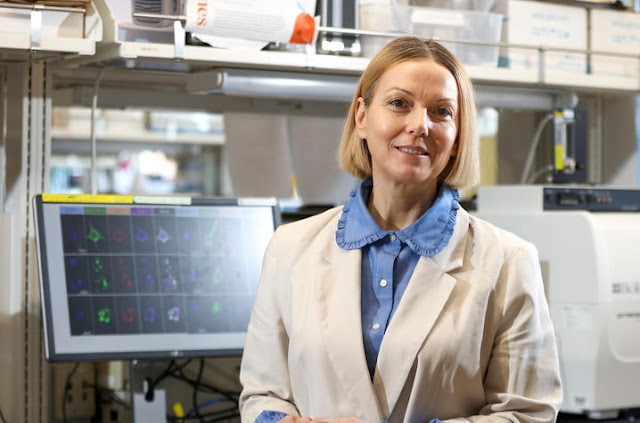 |
| Maj-Linda Selenica, Ph.D., works in her lab on March 27, 2024. (UK photo by Carter Skaggs) |
University of Kentucky
A University of Kentucky professor has received a $3.1 million grant from the National Institute on Aging to continue her research that she thinks could lead to treatments for early dementia.
Maj-Linda Selenica, Ph.D., assistant professor in the UK College of Medicine and associate director of outreach and partnerships at UK’s Sanders-Brown Center on Aging, has been working on research surrounding misfolding of the protein TDP-43, which is common feature of many neurodegenerative diseases, including Alzheimer's disease.
The condition is found in 1 in 5 people over 80. When severe it is associated with episodic memory loss, mimicking Alzheimer's-type dementia, and hastens the cognitive decline in patients with co-existing Alzheimer's pathology,
Proteins that fold into a different, incorrect shape than their normal functional form are often unable to perform their normal functions and can even become toxic to cells. They can clump, which can lead to neurodegenerative diseases like Alzheimer's.
“We have uncovered completely novel modification of TDP-43 that uniquely and irreversibly changes the cellular mechanisms in the brain,” said Selenica.
Citrullination or deimination is the conversion of the
Scientists have few strategies to intervene in the disease process, but Selenica and her lab have discovered that peptidyl arginine deiminases (PADs) promote the conversion of amino acid arginine in TDP-43 to the amino acid citrulline. This process, called citrullination, modifies TDP-43 and may be a potential therapeutic target.
Selenica began her research at the University of South Florida, where her team made novel antibodies for the citrullinated TDP-43, which did not exist as research tools. The team was able to use these antibodies to start looking at the potential mechanisms.
“Alzheimer’s disease brains and dementia brains undergo longstanding stress, so we asked the same thing of the cellular models and cross-validated our findings in animal models,” said Selenica. “We obviously cannot mimic what happens in the human brain, but these models permit us to understand mechanisms that underlie the human disease.”
Selenica’s lab collaborated with Sanders-Brown’s Daniel Lee, an associate professor in the UK College of Medicine and co-investigator on the grant. He was first to investigate the effects of PAD-dependent tau citrullination in Alzheimer's. Their efforts now focus on better understanding how citrullination impacts TDP-43 and other proteins.
The terms “Alzheimer’s disease” and “dementia” are no longer interchangeable. Now scientists understand that a variety of diseases and disease processes contribute to dementia, which is why so much of the ongoing work within the labs at Sanders-Brown are connected in some way. Selenica and Lee’s laboratories are joining forces to focus on two prominent pathological hallmarks in dementia-related diseases.
Selenica’s colleague, Dr. Pete Nelson, a professor of pathology and laboratory medicine at UK and leader of neuropathology at Sanders-Brown, led a group of international experts who characterized TDP-43 effects as a new form of dementia.
Selenica collaborated with Nelson to look at human brain tissues from the UK Alzheimer’s Disease Center Tissue Bank in Sanders-Brown. Nelson is also a co-investigator in this new grant.
Based on her research and the work that planned under the new NIA grant, Selenica is hopeful it can result in several therapeutic avenues to target TDP-43 early in the disease development process.
“I’m hoping that several years from now we can develop disease-modifying therapeutic strategies and future biomarker assays targeting TDP-43 pathology,” Selenica said. And she doesn’t think the work will stop there. “I think this project will open the field to much more fruitful collaborations. It has us really thinking about, could we develop something to target all the pathologies at once?”









0 comments:
Post a Comment